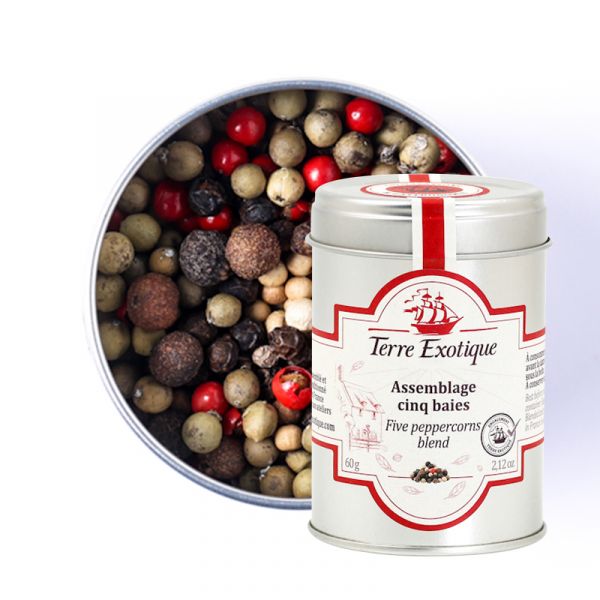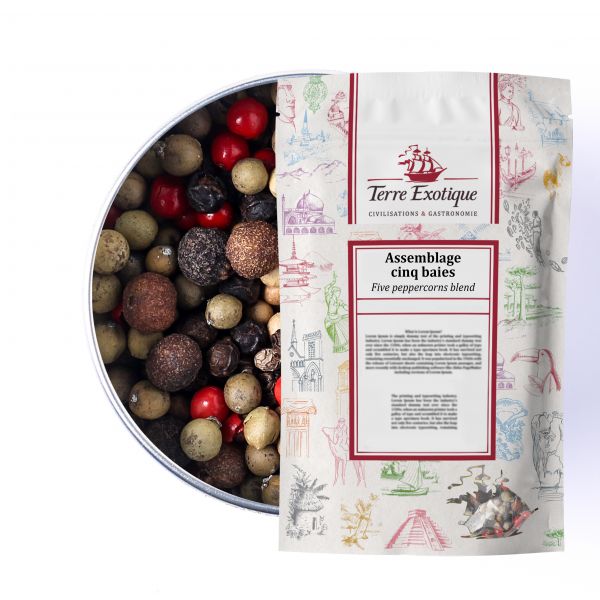





What Dishes to Use Five Peppercorn Blend In?
Explore the Fruity Flavors of Tasmanian Pepper
This five peppercorn blend is composed of exceptional peppers and berries. Grind it over all your dishes for daily refinement. In this blend, you will find our great vintages: Penja white pepper (Cameroon), Penja black pepper (Cameroon), Jamaican pepper (Guatemala), Lyophilized green pepper (Madagascar), and pink berries (Madagascar), a real world tour with five Terre Exotique products!
Attention: due to the rather oily texture of pink berries, we do not recommend putting this blend in a mill; instead, prefer to crush it with a mortar.
How to Use Five Peppercorn Blend?
Here are our recipe ideas for using five peppercorn blend in your cooking:
· foie gras with five peppercorns: crush 2 tablespoons of five peppercorn blend, mix with salt, and spread over the foie gras, then pour cognac on top (find the complete recipe below) ;
· duck breast with five peppercorns : marinate your duck breasts with 2 tablespoons of crushed five peppercorn blend the day before;
· smoked trout toast with five peppercorns: add 2 teaspoons of ground five peppercorns on your toasts before serving;
· grilled flank steak with five peppercorns: crush 1 teaspoon of five peppercorns and sprinkle over your flank steaks at the end of grilling;
· dorado carpaccio: before serving your carpaccio, make 3 twists of the five peppercorn blend grinder and enjoy;
The Aromas of Five Peppercorn Blend
A harmonious blend of colors, powers, and spiciness accompanied by spicy and sweet notes that enhance the simplest dishes. In the mouth, the five peppercorn blend awakens your senses and gives way to a harmony of balanced and spicy flavors.
The Five Berries and Peppers that Compose this Blend
What Does the Five Peppercorn Blend Comprise?
Penja pepper
Piper nigrum is a giant vine that yields Penja pepper. It climbs on a tree with rough and cracked bark that facilitates its ascent, often up to four meters in height. Its pollination occurs through rain, frequent in the Moungo region. In Cameroon, the lands are volcanic, rich, and fertile, making Penja pepper highly concentrated in essential oils and aromas.
In the Moungo province in Cameroon, harvested at optimal maturity, the Penja pepper grains are first washed and then stripped of their pulps before being dried in the sun. The various stages of production of this pepper are manual. They include harvesting, retting, cleaning, drying, and finally sorting. It is the women of the village who carry out the production of this exceptional pepper. Unlike other colors of pepper, white pepper is harvested at optimal maturity. It is then vigorously washed and dried to remove its husk (pericarp).
Jamaican pepper
Jamaican berries are the dried fruits of Pimenta dioica, a tree that can reach 30 meters in height. This tree is native to Mexico and the islands of Cuba, Haiti, and Jamaica; it belongs to the botanical family of Myrtaceae, like Eucalyptus or Manuka. It is not uncommon to hear the name "Jamaican pepper" to refer to these berries. However, Pimenta dioica, not being part of the botanical genus Capsicum, it is inaccurate to call it pepper. That's why at Terre Exotique, we preferred the designation "Jamaican berry" for these berries.
Lyophilized green pepper
This perfectly round and wrinkle-free green pepper is harvested before maturity. Fresh green pepper grains are put in brine (water + salt) in Madagascar and then transported to Europe for lyophilization (dehydration and freezing, under vacuum). The slightly salty taste of this lyophilized green pepper results from the brining phase. Lyophilization allows preserving all the organoleptic qualities of green pepper longer, unlike pepper dried by simple dehydration.
Pink berries
Pink berries are mistakenly nicknamed "pink pepper," but they do not belong to the genus Piper. The scientific name of pink berries is Schinus terebinthifolius. The botanical family to which the pink berry belongs is Anacardiaceae, which includes many trees and shrubs such as sumac, mango, or cashew tree, which produces cashew nuts. Also known as Bourbon pepper, pink berries mainly grow on the island of Madagascar or on the island of Réunion in a dioecious tree that can measure up to 10 meters high and whose growth is very fast. Only berries that have reached full maturity are harvested because they have powerful aromas and are full of flavors. They are then sorted by hand by Malagasy women who possess this unique know-how.
The Origins of the Five Peppercorn Blend
As soon as peppers and berries were discovered, they were mixed together to vary and enhance flavors. It is estimated that the five peppercorn blend was first marketed in the 1960s.In the five peppercorn blend, we find pink berries. Recognizing a quality pink berry is quite an art! Pink berries can be found almost everywhere in commerce, but few are of good quality. A quality pink berry is shiny and perfectly round, it should not be withered. It should be pink, a sign that it was harvested at maturity. At Terre Exotique, when we found our pink berry from Madagascar, we simply fell in love with it.
The five peppercorn blend is available in the custom-made box dedicated to world peppers
| Allergen | Absence |
|---|---|
| Native country | FRANCE |
| Ingredients | black pepper, white pepper, allspice berry, pink peppercorn, green |
| pepper | |
| Nutritional Info | VN Energie pour 100 g (energy for 100g) : 1239 kJ / 296 kcal VN Matière grasse (fat) : 2 g Dont acide gras saturés (of which saturated fat) : 1 g VN Glucides (carbohydrate) : 69 g Dont sucres (of which sugars) : 0.69 g VN Protéines (protein) : 10 g Vn Sel (salt) : 0.005 g |
| TRACES EVENTUELLES D'ALLERGÈNES | céleri, sésame, moutarde, fruits à coques. |
 Français
Français 




